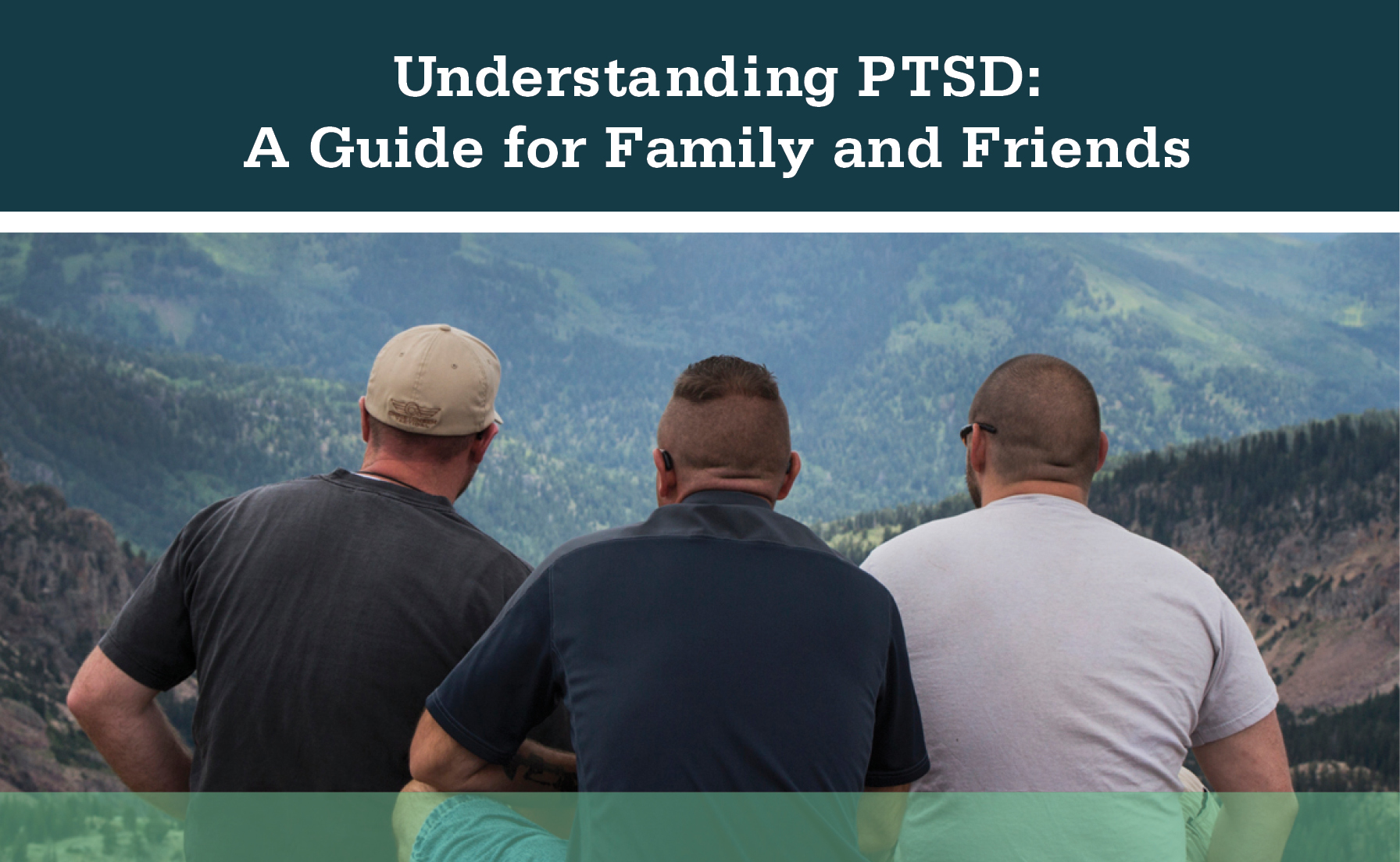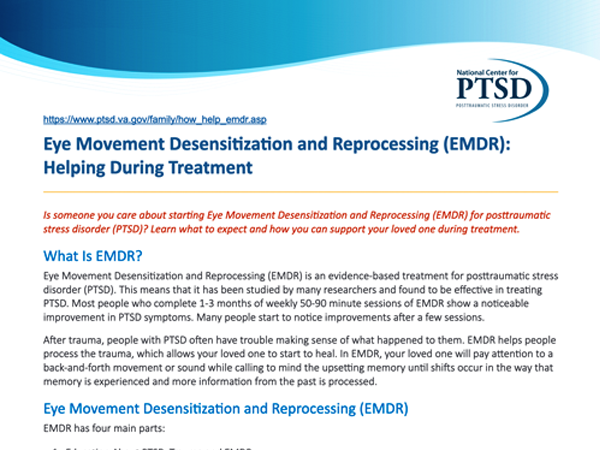PTSD: National Center for PTSD
Eye Movement Desensitization and Reprocessing (EMDR): Helping During Treatment
Eye Movement Desensitization and Reprocessing (EMDR): Helping During Treatment
Available en Español
Is someone you care about starting Eye Movement Desensitization and Reprocessing (EMDR) for posttraumatic stress disorder (PTSD)? Learn what to expect and how you can support your loved one during treatment.
Reading time: minutes
What Is EMDR?
Eye Movement Desensitization and Reprocessing (EMDR) is an evidence-based treatment for posttraumatic stress disorder (PTSD). This means that it has been studied by many researchers and found to be effective in treating PTSD. Most people who complete 1-3 months of weekly 50-90 minute sessions of EMDR show a noticeable improvement in PTSD symptoms. Many people start to notice improvements after a few sessions.
After trauma, people with PTSD often have trouble making sense of what happened to them. EMDR helps people process the trauma, which allows your loved one to start to heal. In EMDR, your loved one will pay attention to a back-and-forth movement or sound while calling to mind the upsetting memory until shifts occur in the way that memory is experienced and more information from the past is processed.
Eye Movement Desensitization and Reprocessing (EMDR)
EMDR has four main parts:
- Education About PTSD, Trauma and EMDR
- Coping Skills
- Processing
- Positive View of the Self Moving Forward
1. Education About PTSD, Physical and Emotional Reactions to Trauma, and EMDR
EMDR starts with education about PTSD and common physical and emotional ways people react to trauma. The therapist will ask your loved one about symptoms, describe what to expect in EMDR, and ask about the goals of treatment. You can help by:
- Knowing the basics is a great place to start. Learning about the impact of trauma, PTSD, and EMDR. The resources listed at the end of this page can help.
- Asking your loved one to share information about what they've learned about PTSD and EMDR from their therapist. You can also ask what a session is like and let your loved one show you how the eye movements, taps or tones work.
2. Learn New Coping Skills
Your loved one will focus on processing trauma memories in therapy. The therapist will talk with your loved one about being ready to do this. Your loved one will learn to create a Calm or Safe Place with the help of the therapist. Other coping skills and ways to manage distress are taught, like learning how to observe and allow processing to occur.
You can expect your loved one to practice calming exercises when needed and to take note of new thoughts and observations to discuss with their therapist. You can help by:
- Giving your loved one some quiet time to practice skills or rest.
- Learning some relaxation techniques for yourself during this time. Your loved one may be able to teach you how or the therapist can help you find information about this.
3. Processing a Target
In EMDR, processing involves identifying and choosing an upsetting memory, referred to as a "target", to focus on during therapy. This target includes negative thoughts, feelings and bodily sensations that are triggered by the memory.
Your loved one will hold the memory in mind while also paying attention to a back-and-forth movement, sensation or sound (like the therapist's finger moving, alternating tap or tone). This lasts for about 30 seconds at a time, and then your loved one will briefly describe any noticeable changes. This continues as your loved one's distress levels go down and new insights, connections and positive emotions are reported.
You can help by:
- Understanding that new information processing may continue between sessions. It's fine to rest for a bit after an EMDR session. Both you and your loved one can generally go about daily life as usual and let changes happen naturally.
- Being willing to listen and understand if your loved one prefers to not discuss what's happening during the sessions. In some instances, it is helpful to say words of encouragement such as "I recognize addressing your PTSD is tough work. I am proud of you for doing it."
- Reminding yourself that it is ok if your loved one feels uncomfortable when focusing on trauma-related memories or beliefs. These feelings are usually brief and your loved one will likely feel better as EMDR continues. Encouraging them to face the difficult feelings may actually help them stick with and finish the treatment.
4. Installing a Positive Belief (for the Future)
At the end of processing, your loved one will focus on a personal, positive belief while holding the memory in mind and paying attention to the movements, taps or tones again. Your loved one will tell the therapist when this new belief feels true without any physical discomfort related to the memory. Towards the end of treatment, the therapist will re-assess PTSD symptoms to see if your loved one needs to process other targets. You can help by:
- Noticing positive changes in your loved one.
- Allowing your loved one time to adjust to a new way of thinking and feeling.
- Reminding your loved one to note any leftover distress and check back in with the therapist as needed.
Wrap Up
EMDR is effective in treating PTSD. Your loved one's decision to start or consider EMDR is a great first step in recovery. Understanding the basics of EMDR will help you support your loved one during the treatment process.
Printable Handout
Eye Movement Desensitization and Reprocessing (EMDR): Helping During Treatment
Download a PDF of this page which discusses what to expect and how you can support your loved one during EMDR treatment.
Additional Resources
There are more videos and programs to support family members or help you learn about trauma, PTSD, and PTSD treatments like EMDR. We recommend:
- AboutFace: Learn about PTSD from Veterans who've experienced it. Listen to their stories and find out how treatment turned their lives around. Hear from family members and clinicians as well.
- Animated Whiteboard Videos: Short videos that use hand-drawn images to describe PTSD and effective treatments, including EMDR.
- Understanding PTSD: A Guide for Family and Friends | Available en Español (PDF): Booklet that includes what you need to know to help yourself and your loved one with PTSD.
- PTSD Family Coach App: Mobile app designed to provide support for concerned family members of those with PTSD.
- VA Caregiver Support: Programs to help you care for the Veteran you love and for yourself.
You May Also Be Interested In

Understanding PTSD: A Guide for Family and Friends (PDF)
What you need to know to help yourself and your loved one with PTSD.


























